Transnational Cartels and Prison/Jail Gangs: A Social Network Analysis of Mexican Mafia (Eme) and La Familia Michoacana Conspiracy Cases
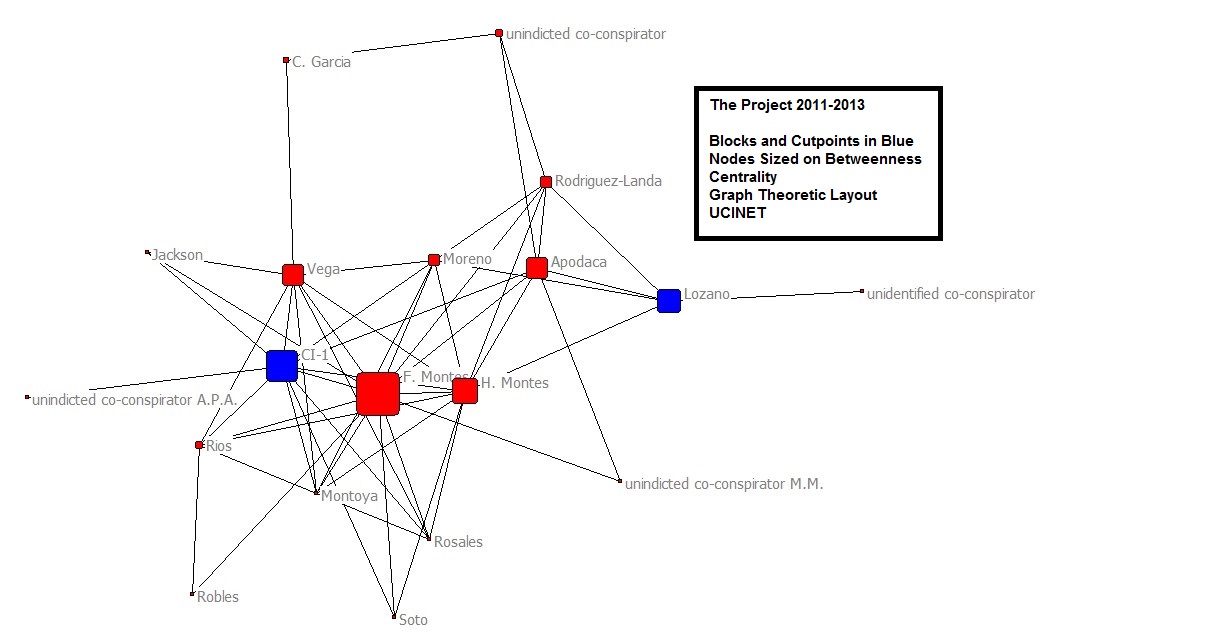
Transnational Cartels and Prison/Jail Gangs: A Social Network Analysis of Mexican Mafia (Eme) and La Familia Michoacana Conspiracy Cases
Isaac Poritzky, Nathan P. Jones, and John P. Sullivan
This article is a mixed methods research study on the Mexican Mafia and La Familia Michoacana (La Familia or LFM), with a focus on their alliance, dubbed “The Project.” Using two indictments of the Mexican Mafia that included an attempt to establish a permanent relationship with the Mexican La Familia drug cartel, we used social network analysis (SNA), relatively new in its current form—though Moreno’s work dates to the 1930s—and underutilized research technique to provide a view of dark networks unachievable through traditional lenses.[1] SNA “can be used to gain a greater understanding of dark networks as well as craft strategies that undermine them.”[2]
This social network analysis case study demonstrates how illicit networks maintain efficiency and resilience through alliances and decentralized governance systems. Despite prosecutions and the names and labels of groups changing, the underlying alliances and drug markets they facilitate continue or are perpetuated.[3] This paper will proceed in the following sections. First, it provides a literature review covering the Project, the Mexican Mafia, La Familia, and some of the SNA literature on criminal networks. Second, it discusses the methods used. Third, it presents a quantitative/qualitative analysis of the Mexican Mafia, La Familia Michoacana, and combined networks. It concludes with policy recommendations.
Literature Review
The literature review will proceed in three sections. First, it discusses the Mexican Mafia gang. Second, it then turns its attention to La Familia Michoacana. Third, it surveys some of the social network analysis literature on criminal networks, which is underutilized but increasing.
Mexican Mafia (Eme)
The Mexican Mafia—known as La Eme, La eMe, or Eme—is a prison gang and network of criminal gangs operating in Southern California. It is known as Eme due to the pronunciation of ‘M,” the 13th letter of the Spanish alphabet. “M” signifies the Mexican Mafia; 13 is often appended to its affiliate gangs’ names to signify their fealty to Eme. Its symbol is traditionally a black hand (often seen in its members’ tattoos). It was formed in California’s corrections system by a group of inmates from East Los Angeles. The inmates initially sought self-protection while incarcerated in the Deuel Vocational Center in Tracy, California. From an initial nucleus of carnales (blood brothers) including Luis “Huero Buff” Flores, Mundo Mendoza, Joe “Peg Leg” Morgan, and Eddie Gonzales, the group now has from 140 to approximately 200–300 or 400 actual members or emeros.[4] Estimated Eme associates (camaradas) and affiliates number about 40,000. The group is active in prisons and is considered a correctional security threat group (STG) due to its violent enforcement activities. It engages in drug trafficking in prisons and jails and through its network of vassals (affiliated Sureño or “Southside” gangs) on the streets.[5]
La Eme acts as a prison-street gang complex projecting its power and influence onto the streets. Its networked entities include 50,000 to 75,00 Sureño gangsters in Southern California, the Aryan Brotherhood, the “old” Arizona Mexican Mafia, and Mexikanemi (Texas Mexican Mafia). Its rivals include La Nuestra Familia (in northern California and its Norteño, “Northsider” gang affiliates), the “New” Arizona Mexican Mafia, Barrio Azteca (Los Aztecas), the Texas Syndicate, the Black Guerilla Family, and black street gangs. Four factions of Eme have been documented: California faction, Federal factions, Arizona faction, and Hawaiian faction.[6] Eme collects street taxes from its subordinate gangs and maintains discipline through its ability to punish those that fail to pay tribute by authorizing enforcement activities, up to and including authorizing targeted murder in prison or on the streets by authorizing a “Luz Verde” or “green light” for action.[7]
Eme has documented ties with the Mexican drug trafficking enterprise known as the La Familia cartel or La Familia Michoacana (LFM), as seen in Federal indictments in Los Angeles (the Central District of California).[8] In that indictment, members of Eme and La Familia were seeking to establish a joint venture known as “The Project,” giving LFM latitude to sell methamphetamine in Southern California in return for Eme providing protection for LFM members in custody and paying Eme with cash and meth. This paper examines the network connections between Eme and LFM. It follows the template employed in a social network analysis (SNA) of the relationship between the Cártel de Jalisco Nueva Generación (CJNG) and the Sinaloa Cartel, and their respective affiliates in a working paper by Nathan Jones et al.: Mexico’s 2021 Dark Network Alliance Structure.[9]
La Eme is one of the most powerful prison/jail gangs in the United States. From its roots in California’s prison system, its power, control (and reach) extend throughout Southern California, including jails in Los Angeles, Orange, and San Diego Counties), throughout the California and Arizona prison systems, to the Federal Bureau of Prisons, and correctional facilities throughout the West Coast and Southwestern United States. From their prison or jail cells, Eme directly influences gang activities on the streets through its network of over 400 individual Sureño (Southsider) gangs originating with a current presence in all 50 US states and into Mexico and Central America.[10]
La Familia (LFM)
La Familia—also known as La Familia Michoacana (LFM) or the Michoacán Family—is a Mexican criminal cartel formed in the 1980s as a vigilante group in Michoacán.[11] Its power and influence reached to the neighboring states of Guerrero, Mexico, and Jalisco at its peak. La Familia gained global notoriety when it stormed the Sol y Sombra nightclub in Uruapan in September 2006. In that incident, 20 masked sicarios (cartel gunmen) shot their guns into the air and tossed six bloody, severed heads onto the dance floor. A narcomanta (placard) proclaimed the cartel’s message: “The family doesn’t kill for money. It doesn’t kill for women. It doesn’t kill innocent people, only those who deserve to die. Know that this is divine justice.”[12]
LFM was a powerful regional polydrug organization centered in Mexico’s Tierra Caliente region with political influence throughout central and western Mexico. Its reach extended south to Central America and north to the United States, where its distribution network operated in California (especially Los Angeles, San Diego, and its twin-city Tijuana in Baja California), El Paso and Houston in Texas, Illinois, and Atlanta, Georgia. It was known to co-operate with the Sinaloa Cartel (in addition to Eme, the Mexican Mafia, a Sinaloa ally). La Familiautilized religious imagery to bind its members through evangelical statements and sayings. Its leader, Nazario Moreno Gonzáles, “El Mas Loco,” also formed the LFM splinter group known as Los Caballeros Templarios(the Knights Templar).[13] The two groups, while sharing common founders, became competitors. Both LFM and the Templarios employed social banditry and narcocultura to solidify their power with San Nazario (“El Mas Loco”), extolling the virtues of sacramental violence.[14]
The La Familia cartel is still extant; however, it is much weaker, and essentially only remnants in direct confrontation with the CJNG still function in Michoacán. At its peak, it had links with both Sureño and Norteñogangs in California, giving it access to a lucrative distribution capacity. Offshoots of the LFM include La Nueva Familia Michoacana, which is allied with Los Viagras against both the CJNG and LFM.[15] The ongoing battle with the CJNG in Michoacán currently involves an alliance between LFM and the Cártel de Los Correa, where both specialize in the fabrication of synthetic drugs, cultivating marijuana, kidnapping, vehicle theft, and extortion.[16] LFM, like many criminal cartels, is a protean network with components, allies, and splinter groups constantly evolving to meet changing conditions. This constantly evolving organizational structure makes retrospective analysis important to understanding the shifting nature of cartel networks.
SNA Literature
The most common visual mapping tool is “link analysis,” but link analysis has very little mathematical consideration and neglects the fact that perceptions of relational patterns are heavily affected by the layout of graphs.[17] Since the human eye is easily misled by the arbitrary layout of visual graphs, drawing conclusions based on such graphs is not a statistically sound method. Some consider social network analysis the scientific equivalent of link analysis. It is not so much a theory but rather a theoretical and methodological paradigm for examining complex social structures.[18] The technique allows for much wider applications than simply graphs. That is, in addition to visualizations of network graphs, SNA is an arithmetical technique that analyzes relational patterns of nodes (actors) and connections (ties) based on mathematical computations.[19] To display the usefulness of SNA, Cunningham et al. cite an example where a mid-level leader in a dark network would not receive significant attention due to his lack of formal prestige, but with SNA, we can see that they are a charismatic recruiter and creative operational planner because of his recruiting and operational ties.[20] These strengths are difficult to detect from his hierarchical position but are only displayed through the actor’s structural relations.
While SNA has been underutilized in criminal network analysis, that is changing. There are now criminal network analysis textbooks[21] and literature reviews on SNA and court records and SNA on drug networks.[22] Natarajan was one of the first to use qualitative court records to create quantitative SNA data.[23] Jones et al. applied some of those methods to a cross-border drug network.[24] Sollano used SNA to assess the criminal indictment of Genaro García Luna, the former head of Mexican security services now criminally charged in the United States.[25] Costa has assessed corruption and money laundering. Salcedo-Albarán and Garay-Salamanca have assessed hydrocarbon theft networks in Mexico via SNA.[27] David Bright et al. have assessed the evolving dynamics of drug networks.[28] The aforementioned examples are merely a sampling of the increasing literature on criminal network analysis.
Methods
The authors searched official US court documents, including indictments, testimonies, and transcripts, obtained from PACER, which is the federal court electronic access system. The two most notable documents involve the defendant Jose Rodriguez–Landa. They are United States v. Rodriguez-Land, et al. (2013)[29] and United States v. Rodriguez-Landa, et al. (2016).[30] Using these indictments, the authors were able to take qualitative data and input it into UCINET to create a detailed visual map of the relationships between the Mexican Mafia and La Familia, with a focus on the actors within each group.
The authors created three separate data sets. The first is coded solely from the February 2013 Grand Jury indictment of the Mexican Mafia and La Familia. The second is coded from the 136-page June 2016 Grand Jury indictment of the Mexican Mafia. Data set three is a combination of the two aforementioned networksdrawn from over two hundred pages of indictments. The authors combined the data sets together because two of the actors in the first data set were also charged in the second, Jose Rodriguez-Landa and Luis Gerardo Vega. It is important to note that these two actors’ names appeared slightly different in each indictment, so for ease of understanding, they will be referred to as Rodriguez-Landa and Vega.
The networks are undirected. This means that the relationships are non-directional by nature. To ensure consistency, ties were only coded when the indictment clearly stated that the two actors communicated in some way (i.e., telephone, “kite” or informal written communication, physical meeting, or overt act). The authors did not record a tie when actors stated that they planned on talking to somebody or had heard some piece of information; rather, it had to be clear that two actors had a discussion that constituted an overt act in the conspiracy charge. Also, if there were multiple overt acts detailed in a single conversation, the authors coded that as one tie instead of multiple where that could be identified.
Topography Metrics (Table 1)
The following metric definitions largely draw from Sean Everton’s 2013 book Disrupting Dark Networks. We use average degree and density to determine the density or sparseness of the networks. Density is the number of ties divided by the number of possible ties. Average degree (average number of ties per actor) is a better metric for comparing between networks as density tends to go down with larger networks. Diameter is the longest geodesic or shortest path across the network. Components are connected portions of the network. The main component is the largest connected grouping within the network and is often used in SNA to simplify analysis of the main relevant portion of the network. For centrality measures (Table 2), we use degree (count of an actors ties), betweenness centrality, which is defined as the proportion an actor is on the shortest path between all pairs of actors, and eigenvector centrality which takes into account each actor’s ties to well-connected actors. The Girvan–Newman algorithm detects subclusters of actors whose density is greater than one would expect by chance (See Figure 3).[31]
Social Network Analysis Mexican Mafia (Eme) and La Familia Michoacana (LFM)

Figure 1. The Project 2011-2013
To ensure the longevity and success of “The Project,” both groups tried to make individuals members of both organizations, a point discussed in previous research.[32] The Mexican Mafia particularly attempted to co-opt members of La Familia through money and drugs.
The actors highlighted in blue above play key roles in the network. Their removal would cut off large portions of the network, making them cutpoints or blocks. CI-1 is colored blue because that person was the confidential informant that much of the indictment was based on, so many of the relationships revolve around CI-1, even if they are not the most high-ranking member. Lozano, on the other hand, is a key member because he facilitated communications between La Familia and the incarcerated Mexican Mafia members. He was one of the main redundant connections to Apodaca and Rodriguez-Landa, so his position is an essential “brokerage” position (Figure 1).
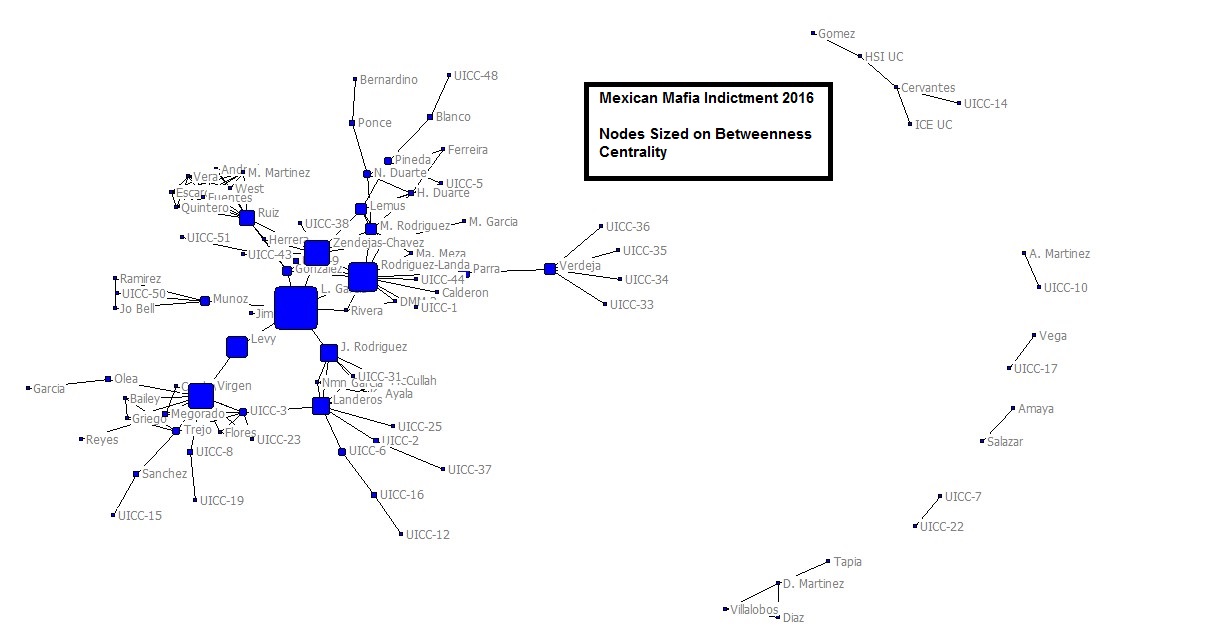
Figure 2. Mexican Mafia Key Brokers
The Mexican Mafia is a prison/jail gang that controls some Federal prisons and California state jails. The 2016 indictment focuses on the Los Angeles County Jail System (LACJS) and the Mexican Mafia members involved in that system, either incarcerated or out on the street.
These network nodes (Figure 2) vary in size based on betweenness centrality. The Mexican Mafia is organized differently than La Familia. In La Familia, the network is rather dense, and nearly everyone is connected; a rarity for dark networks. The Mexican Mafia, partially due to the unique nature in which they exist, has more distinct isolates, and we can see that the actors who connect the isolates are important. Laureen Garcia (L. Garcia), an associate, acting as a “secretary” or messenger for Eme in the jail, serves an important role as she connects nearly half the network to Rodriguez-Landa. The other important actor is Zendejas-Chavez, as he serves as the attorney for many Mexican Mafia members. Unlike most other members who primarily connect exclusively to their component, Zendejas-Chavez is used where needed and bridges many groups. From an intelligence perspective, Zendejas-Chavez is the most unique member and connects distinct parts of the Mexican Mafia.
It is interesting to note that Vega, who played a significant role in “The Project,” is disconnected from the main component here in the 2016 indictment (Figure 2). You can see that in Figure 5, Vega has an average betweenness centrality because he was a key player in “The Project,” yet here, he is unimportant. That could possibly be because they wanted to limit his exposure and because of his high rank in the Mexican Mafia. Thus, he does not get involved in less important business. In effect, he is insulated through proxies. Scholars such as Michael Kenney (2007) and Nathan Jones et al. (2018) have identified the importance of cut outs and proxies in network structures.[33]
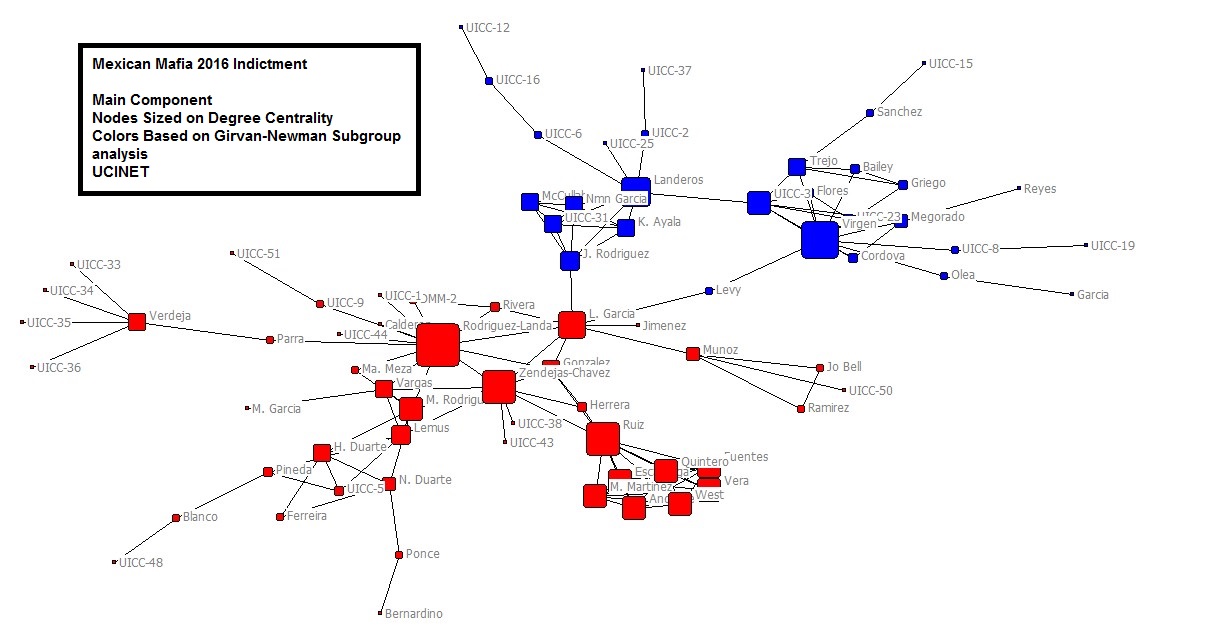
Figure 3. Mexican Mafia 2016 Subgroup Analysis
Figure 3 provides a Girvan-Newman Subgroup analysis of the 2016 indictment. The analysis generated two subgroups depicted in red and blue. In Figure 3, the blue group overlaps significantly with two distinct jail facilities in the LACJS network. Virgen appears as a key connector between the main group and her sub-group. She is a “secretary“ controlled by Daniel Cervantes’ (one of the high-ranking “facilitators”) and Cervantes does not even appear in the visualization. Cervantes could use Virgen as the main connector to the conspiracy to insulate himself. The red side is mainly controlled by Rodriguez-Landa, and he uses L. Garcia as the key connector to the blue group. This is clearly a purposeful choice and allows the Mexican Mafia to be less dense. This is a classic example of the security versus efficiency tradeoff illicit networks often make.[34] This visualization clearly displays the Mexican Mafia organizational design, as we can see Virgen, J. Rodriguez, and Ruiz act as the connectors to their respective correctional facilities.
The authors combined these two networks (The Project 2013 indictment and the Mexican Mafia 2016 Indictment networks) because Luis Vega and Jose Rodriguez-Landa, two important members in the Mexican Mafia, were charged in both, allowing for a unique opportunity to demonstrate how illicit networks span transnational boundaries and make themselves resilient.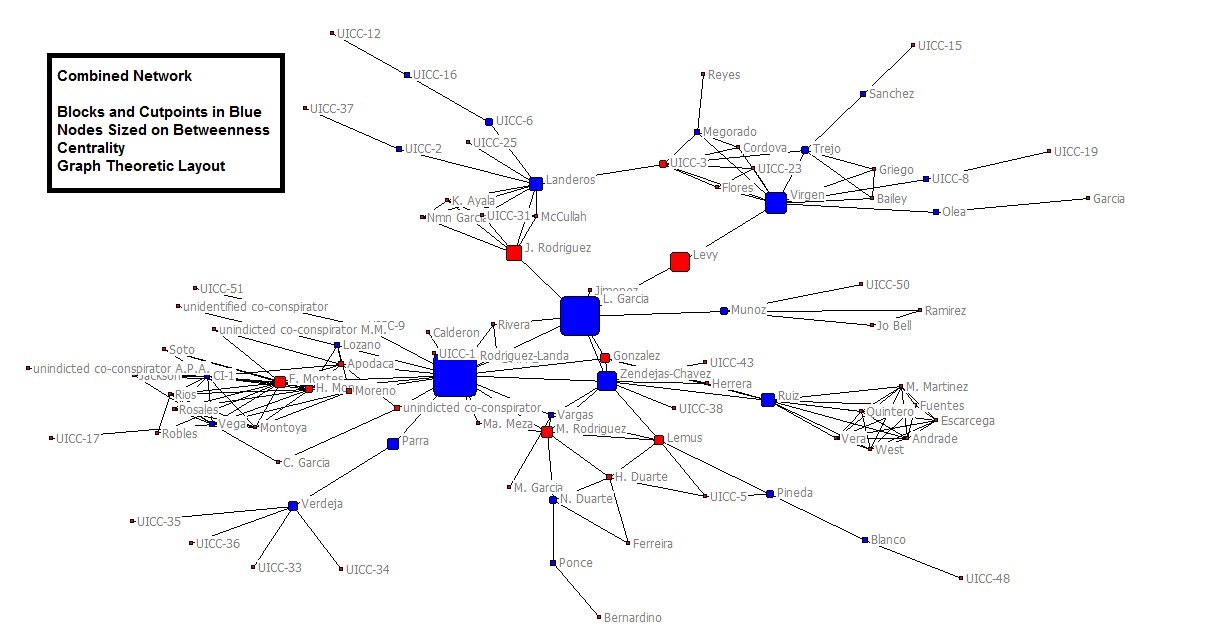 Figure 4. Combined Network Blocks and Cutpoints
Figure 4. Combined Network Blocks and Cutpoints
This visualization (Figure 4) displays the importance of the actors highlighted in blue, as their removal would cause large sections of the network to fall off. Rodriguez-Landa is the obvious one, as he is the leader and brings the entire network together around him. It is surprising that he is the most important as one would assume that he would want to separate himself from much of the business, but on the other side, it ensures that he is relevant despite his incarceration in Pelican Bay. Again, we see Laureen Garcia, an associate, plays an important role as a “secretary” for Eme at North County Facility (NCCF) and connects many of the incarcerated individuals. Virgen plays a similar role to L. Garcia. Landeros controlled activities at Men’s Central Jail (MCJ) and Twin Towers Correctional Facility (TTCF) in 2013, which explains why he is an important cut point for individuals in that facility.
The last individual to highlight is Vega, as he is an important connector to the La Familia cartel. Vega is second in command to Rodriguez-Landa and was put in charge of “The Project,” yet does not appear often in the Mexican Mafia indictment.
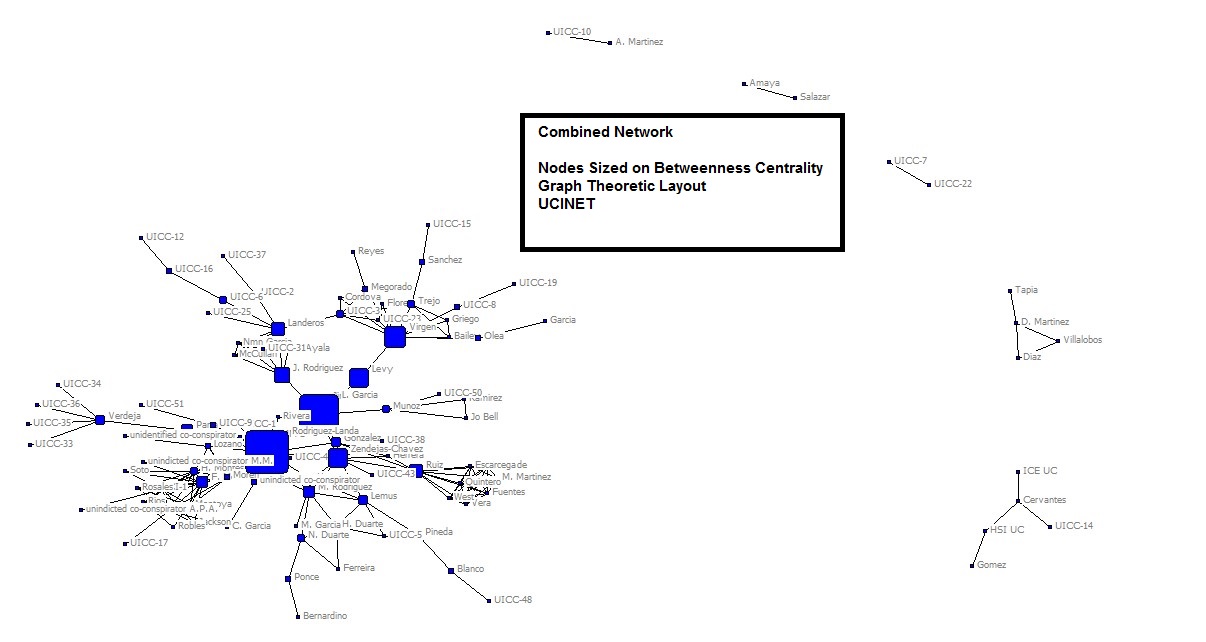
Figure 5. Combined La Familia Mexican Mafia Network (data set 3)
Figure 5 shows the combined network with nodes sized on betweenness centrality and isolates removed. This visualization (Figure 5) generally aligns with the expected results. Jose “The Fox” Rodriguez-Landa, leader or “shot caller” in the Mexican Mafia was in charge of “The Project.” He holds the most power hierarchically and is close to other powerful members, causing him to have a high betweenness centrality. Actors who frequently operate as the ‘quickest’ bridge connection by means of shortest paths between other actors (high scores on betweenness centrality) are powerful key players for the core business of the network and have the ability to isolate, influence, manipulate or prevent contact between other parties.[35]
Zendejas-Chavez has an unusually high betweenness centrality because he is an attorney who helps Rodriguez-Landa and others conduct Mexican Mafia business. We see Laureen Garcia appears to play a large role as she acts as a “secretary” at the North County Correctional Facility (NCCF), meaning that she controls all information in and out of that facility. The actors that report directly to Rodriguez-Landa are Zendejas-Chavez, Laureen Garcia, Alvino Munoz, Daniel Cervantes, Miguel Carderon, Ernesto Vargas, Miguel Rodriguez, Gilbert Parra, Gerardo Tapia, and Donato Gonzalez. We can see that most of these men are close to Rodriguez-Landa and often serve as a connection for a large group of actors. L. Garcia is interesting as she has the highest betweenness centrality of any actor.
What is also interesting to note is that the bottom left section of Figure 5 is all La Familia members. The Montes brothers (a third brother was not charged) were in charge of “The Project” on the La Familia end. They served as the representatives for La Familia and played the largest roles in the Project, providing the drug proceeds to Mexican Mafia members. Moreno, Apodaca, and Lozano served as the main coordinators for the Mexican Mafia between incarcerated individuals and individuals on the street. Moreno, Montoya, and Vega were the first ones tasked with beginning “The Project” and brought on the Montes brothers. Toward the end of the Project, Vega discussed using his ties to the Mexican drug cartels to go around the Montes brothers. That is difficult to see in the visualization as his Mexican drug cartel connections are not included in the indictment.
It is surprising that Apodaca’s betweenness centrality is so low since she served as a key messenger for Rodriguez-Landa. It is generally assumed that women serve an insignificant role in gang activity, but women are used by the Mexican Mafia to smuggle notes (“kites”) and serve as intermediaries between incarcerated and freed members.[36]
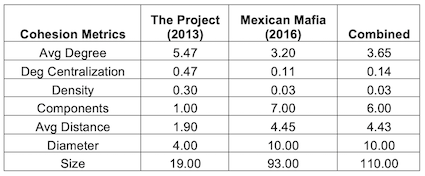
Table 1. Cohesion Outputs UCINET for All 3 Networks
Table 1 above shows all of the dark networks analyzed here are sparse, with the exception of the Project, which at .3 is fairly dense for a dark network. Average degree is a better metric than density for comparing networks of different sizes. Thus, the average degree of 5.47 (project network) vs. 3.28 for the 2016 indictment is a better metric to show the greater concentration of ties than density in that network. Nonetheless, the density of .03, with the exception of The Project network, which is dense for a dark network at .30.[37] The average degree is also higher for that network, which is consistent with the visualizations which demonstrate that it has no isolates and, thus, only one component. The Project indictment has the shortest diameter suggesting that the network is better connected but also more vulnerable to prosecution.
The density of “The Project” makes sense as Rodriguez-Landa wanted this alliance to be successful, so both groups attempted to keep the individuals involved in the alliance small, yet tightly connected. This allowed them to share information quickly and be more responsive to change. La Familia members involved were a much smaller group than the Mexican Mafia, so they had less risk due to exposure, allowing them to be more dense, which increases effectiveness but decreases covertness.[38]
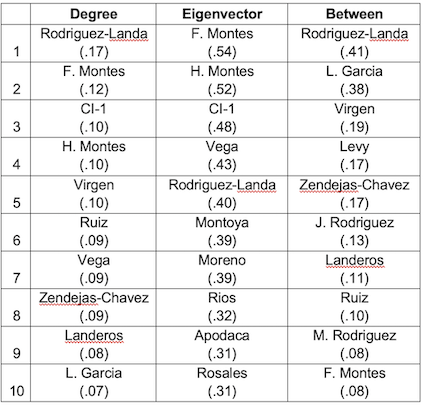
Table 2. Combined Network Centrality Rankings (Top 10)
The degree centrality ranking in Table 2 aligns with the expected results as we see Rodriguez-Landa (the Mexican Mafia shot caller in the LA County Jails) at number one in degree and betweenness centrality but not at eigenvector centrality. Since “The Project” network was smaller and more densely connected, it makes sense that the Montes brothers are in the top four (degree and eigenvector) as they were integral in the formation of the alliance. It is interesting that Vega shows up so high on degree centrality, yet in the Mexican Mafia visualizations, he sometimes is an outlier or does not show up at all.
Interestingly, when we look at eigenvector centrality, Apodaca has the ninth highest (.31). This makes sense because she herself does not have significant power, but she is essential for the functioning of the network,and Rodriguez-Landa relies on her heavily. The two highest eigenvector centralities are, unsurprisingly, H. Montes (.54) and F. Montes (.52). They serve very important brokerage roles along with Vega, who has the fourth highest at .43.
The actors with the highest degree centrality are the Montes brothers, CI-1, Rodriguez-Landa, and Virgen. Actors with many direct contacts (high scores on degree centrality) play an active role in the network and are assumed to have access to multiple behavioral alternatives, which makes them less dependent on others and more powerful.[39] Zendejas-Chavez (ranked 7th on degree centrality) is an interesting case as he is not technically a member of the Mexican Mafia but assists most of the high-level members.
Conclusions
The network analysis of the Mexican Mafia and La Familia Michoacana networks related to the Project and the subsequent Mexican Mafia indictment in 2016 provides numerous lessons about the network structures of illicit networks. First, through alliances, illicit networks can become transnational. Second, by networking across networks, illicit networks take advantage of each other’s relative strengths, as Phil Williams and Irina Chindea have described.[40] The Mexican Mafia brought the capacity to control the prisons in California, a major distribution market but also through their street gang control to serve as distributors. This was incredibly valuable to La Familia, which could provide drug sourcing contacts. Interestingly, it was the Mexican Mafia that appeared in a stronger position, as demonstrated when some members considered using alternate contacts in the Mexican cartel world to go around La Familia intermediaries. Third, the analysis of the two indictments, one in 2013 and the other in 2016, also demonstrated the resilience of the Mexican Mafia and its individual members, which continued to provide leadership roles across multiple indictments years apart.
Most importantly, this paper has provided an empirically grounded mixed methods case study of the internal organizational structures of the Mexican Mafia using social network analysis and court documents. Future research should assess more recent Mexican Mafia cases and their international connections to other organized crime groups in Mexico and throughout Latin America. In addition, future research could apply this SNA methodology to other criminal groups, such as MS-13, which have transnational linkages and a presence in correctional facilities in the US and in Central America.
Endnotes
The authors thank the anonymous reviewers for their comments. Their suggestions improved our final paper. Any omissions or errors are ours alone.
Disclaimer: It should be noted that, not all individuals found in this study are assumed to be guilty or have been proven so via conviction in a court of law. The presumption of innocence is an important concept that applies to the actors discussed here.
[1] For a discussion of the history and development of social network analysis See: Linton C. Freeman, The Development of Social Network Analysis: A Study in the Sociology of Science. Vancouver: Empirical, 2004. For a practical overview of SNA for practitioners See: Sean F. Everton, Disrupting Dark Networks. New York: Cambridge University Press, 2012. All software analysis for this article was conducted in UCINET see: Stephen P. Borgatti, Martin G. Everett, and Linton C. Freeman. “Ucinet for Windows: Software for Social Network Analysis,” 2002.
[2] Daniel Cunningham, Sean Everton, and Philip Murphy, Understanding Dark Networks: A Strategic Framework for the Use of Social Network Analysis. London: Rowman & Littlefield. 2016, p. xvii.
[3] Irina Chindea, “Fear and Loathing in Mexico: Narco-Alliances and Proxy Wars,” Fletcher Security Review, Vol. 1, no. 2., 2014, http://media.wix.com/ugd/c28a64_4f406b0a66314668aae6a81a4066465a.pdf; Phil Williams, “Transnational Criminal Organizations: Strategic Alliances,” Washington Quarterly, Vol. 18, no. 1. 1995: pp. 57–72, https://www.tni.org/es/node/6113.
[4] Petra Godesa, “Rules the Mexian Mafia have to Follow,” Grunge, 19 October 2021, https://www.grunge.com/636745/rules-the-mexican-mafia-have-to-follow/.
[5] John P. Sullivan, “La Eme (Mexican Mafia),” in Jeffrey Ian Ross, ed., Encyclopedia of Street Crime in America. Thousand Oaks: Sage. 2013, pp. 235–236, https://sk.sagepub.com/reference/encyclopedia-of-street-crime-in-america/n98.xml.
[6] Al Valdez and Rene Enriquez, Urban Street Terrorism: The Mexican Mafia and the Sureños, Second Edition. Spartenburg, SC: Police & Fire Publishing, 2019.
[7] Op. cit., Sullivan, “La Eme” at Note 5; John P. Sullivan, “Future Conflict: Criminal Insurgencies, Gangs and Intelligence,” Small Wars Journal, 31 May 2009, https://smallwarsjournal.com/jrnl/art/future-conflict-criminal-insurgencies-gangs-and-intelligence.
[8] “13 Linked To Mexican Mafia And La Familia Indicted After Investigation Reveals Plot To Join Forces To Expand Drug Cartel’s Presence In U.S.” Press Release, US Attorney’s Office for the Central District of California, 6 August 2013, https://www.justice.gov/usao-cdca/pr/13-linked-mexican-mafia-and-la-familia-indicted-after-investigation-reveals-plot-join. For an early discussion of “the Project” as an example of transnational criminal networks see “Gangs Beyond Borders: California and the Fight Against Transnational Organized Crime.” Sacramento: Office of the Attorney General. March 2014: p. 32, https://oag.ca.gov/sites/all/files/agweb/pdfs/toc/report_2014.pdf.
[9] Nathan P. Jones, Irina Chindea, Daniel Weisz-Argomedo, and John P. Sullivan, “Mexico’s 2021 Dark Network Alliance Structure: An Exploratory Social Network Analysis of Lantia Consultores’ Illicit Network Alliance and Subgroup Data.” Working Paper, Houston: Center for the United States and Mexico, Rice University’s Baker Institute for Public Policy. April 2022, https://doi.org/10.25613/KMGB-NC83.
[10] Op. Cit., Valdez and Enriquez at Note 6.
[11] George W. Grayson, La Familia Drug Cartel: Implications for U.S.-Mexican Security. Carlisle Barracks: Strategic Studies Institute, US Army War College. 2010, https://press.armywarcollege.edu/monographs/590/.
[12] Samuel Logan and John P. Sullivan, “Mexico’s ‘Divine Justice,’” ISN ETH Zürich, 17 August 2009, https://www.academia.edu/9203722/Mexico_s_Divine_Justice_.
[13] Robert J. Bunker and Alma Keshavarz, eds., Los Caballeros Templarios de Michoacán: Imagery, Symbolism, and Narratives, Bethesda: Small Wars Foundation. 2019, https://www.academia.edu/38806893/Los_Caballeros_Templarios_de_Michoacán_Imagery_Symbolism_and_Narratives.
[14] John P. Sullivan, “Postscript: Narcocultura, Insurgencies, and State Change,” in Robert J. Bunker and Alma Keshavarz, Eds., Los Caballeros Templarios de Michoacán, pp. 117–122; John P. Sullivan, “Los Caballeros Templarios: ‘Social Bandits,’” The Counter Terrorist, Vol. 5, no. 6, December 2012/January 2013, https://www.academia.edu/11193325/Los_Caballeros_Templarios_Social_Bandits_.
[15] Francisco Castellanos, “Enfrentamiento entre CJNG y Nueva Familia-Viagras deja dos muertos en Michoacán,” Proceso, 21 November 2017, https://www.proceso.com.mx/nacional/2017/11/21/enfrentamiento-entre-cjng-nueva-familia-viagras-deja-dos-muertos-en-michoacan-195227.html.
[16] “¿Quiénes son Los Correa, presuntos responsables de la masacre en Zinapécuaro?” Publimetro, 30 March 2022, https://www.publimetro.com.mx/noticias/2022/03/30/quienes-son-los-correa-presuntos-responsables-de-la-masacre-en-zinapecuaro/.
[17] Op. Cit., Cunningham, Everton, and Murphy at Note 2.
[18] Stanley Wasserman and Katherine Faust, Social Network Analysis: Methods and Applications, Structural Analysis in the Social Sciences. New York: Cambridge University Press.1994; Mustafa Emirbayer, and Jeff Goodwin, “Network Analysis, Culture, and the Problem of Agency.” American Journal of Sociology. Vol. 99, no. 6. 1994: pp. 1411–1454, https://www.journals.uchicago.edu/doi/10.1086/230450.
[19] Op. Cit., Everton at Note 1.
[20] Op. Cit. Cunningham, Everton, and Murphy at Note 2.
[21] Gisela Bichler, Understanding Criminal Networks: A Research Guide. Berkley: University of California Press, 2019.
[22] Gisela Bichler, Aili Malm, and Tristen Cooper, “Drug Supply Networks: A Systematic Review of the Organizational Structure of Illicit Drug Trade,” Crime Science. Vol. 6, no. 1. 2017, https://doi.org/10.1186/s40163-017-0063-3; David Bright, Russell Brewer, and Carlo Morselli, “Using Social Network Analysis to Study Crime: Navigating the Challenges of Criminal Justice Records.” Social Networks. Vol. 66 (1 July 2021): pp. 50–64, https://doi.org/10.1016/j.socnet.2021.01.006.
[23] Mangai Natarajan, “Understanding the Structure of a Large Heroin Distribution Network: A Quantitative Analysis of Qualitative Data.” Journal of Quantitative Criminology, Vol. 22, no. 2. 2006: pp. 171–92, https://doi.org/10.1007/s10940-006-9007-x; Mangai Natarajan, “Understanding the Structure of a Drug Trafficking Organization: A Conversational Analysis.” Crime Prevention Studies, Vol.11. 2000: pp. 273–98, https://www.researchgate.net/publication/238097384_UNDERSTANDING_THE_STRUCTURE_OF_A_DRUG_TRAFFICKING_ORGANIZATION_A_CONVERSATIONAL_ANALYSIS.
[24] Nathan P. Jones W. Layne Dittmann, Jun Wu, and Tyler Reese, “A Mixed Methods Social Network Analysis of a Cross-Border Drug Network: The Fernando Sanchez Organization (FSO).” Trends in Organized Crime. Vol. 23, no. 2. 2020, pp. 154–82, https://doi.org/10.1007/s12117-018-9352-9.
[25] Francisco Sollano Jr, “A Social Network Analysis of Genaro García Luna and His Alleged Ties to the Sinaloa Cartel,” Small Wars Journal, 11 January 2022, https://smallwarsjournal.com/jrnl/art/social-network-analysis-genaro-garcia-luna-and-his-alleged-ties-sinaloa-cartel.
[26] Costa Jacopo, “The Nexus between Corruption and Money Laundering: Deconstructing the Toledo-Odebrecht Network in Peru,” Trends in Organized Crime, 2022, https://doi.org/10.1007/s12117-021-09439-6.
[27] Eduardo Salcedo-Albarán and Luis Jorge Garay Salamanca, “Structure of a Transnational Criminal Network: ‘Los Zetas’ and the Smuggling of Hydrocarbons,” Working Paper No. 12. Bogotá: Vortex, 2014, https://www.researchgate.net/publication/284545521_Structure_of_a_Transnational_Criminal_Network_Los_Zetas_and_the_Smuggling_of_Hydrocarbons.
[28] David Bright, Johan Koskinen, and Aili Malm. “Illicit Network Dynamics: The Formation and Evolution of a Drug Trafficking Network.” Journal of Quantitative Criminology. Vol. 35, no. 2. 2019: pp. 237-58, https://doi.org/10.1007/s10940-018-9379-8.
[29] United States District Court Central District of California, Superseding Indictment: United States v. Jose Landa-Rodriguez, et. al.June 2016, https://www.courthousenews.com/wp-content/uploads/2018/05/Dirty-Thirds-jail-case-Landa-Rodriguez-et-al-INDICTMENT.pdf.
[30] United States District Court Central District of California, Superseding Indictment: United States v. Jose Rodriguez-Landa, et. al. February 2013, https://www.courtlistener.com/docket/5873764/united-states-v-rodriguez-landa/.
[31] Op Cit., Everton at Note 1; See Girvan, Michelle, and Mark E. J. Newman. 2002. “Community Structure in Social and Biological Networks.” Proceedings of the National Academy of Sciences USA. Vol. 99, no. 12. 2002, pp. 7821–26. Cited in “NETWORK > SUBGROUPS > GIRVAN-NEWMAN,” UCINET, 2002, http://www.analytictech.com/ucinet/help/hs4119.htm.
[32] Nathan P. Jones, “Bacterial Conjugation as a Framework for the Homogenization of Tactics in Mexican Organized Crime,” Studies in Conflict & Terrorism, Vol. 44, no.10. 2021: pp 864-865, https://doi.org/10.1080/1057610X.2019.1586356.
[33] Op. Cit., Jones at Note 24; Nicholas Dorn, Lutz Oette, and Simone White, “Drugs Importation and the Bifurcation of Risk Capitalization, Cut Outs and Organized Crime,” British Journal of Criminology. Vol. 38, no. 4. 1998: pp. 537–60, https://www.jstor.org/stable/23638737; Michael Kenney, “The Architecture of Drug Trafficking: Network Forms of Organisation in the Colombian Cocaine Trade,” Global Crime. Vol. 8, no. 3. 2007: pp. 233–59, https://doi.org/10.1080/17440570701507794; Michael Kenney, From Pablo to Osama: Trafficking and Terrorist Networks, Government Bureaucracies, and Competitive Adaptation. University Park: Pennsylvania State University Press. 2007.
[34] Carlo Morselli, Cynthia Giguère, and Katia Petit, “The Efficiency/Security Trade-off in Criminal Networks,” Social Networks. Vol. 29, no. 1. 2007: pp. 143–53, https://doi.org/10.1016/j.socnet.2006.05.001.
[35] Kathryn Oliver, “Covert Networks: Structures, Processes and Types.” Mitchell Centre Working Paper. 25 June 2014: p. 8, https://hummedia.manchester.ac.uk/schools/soss/research/mitchell/covertnetworks/wp/working_paper1.pdf.
[36] Some previous SNA research has also demonstrated this counterintuitive finding. Paul A.C. Duijn and Peter P.H.M. Klerks, “Social Network Analysis Applied to Criminal Networks: Recent Developments in Dutch Law Enforcement,” Networks and Network Analysis for Defence and Security. 2014: pp. 121-159, https://doi.org/10.1007/978-3-319-04147-6_6.
[37] Op. Cit., Oliver at Note 35.
[38] Op. Cit., Morselli, Giguère, and Petit at Note 34.
[39] Op. Cit., Oliver at Note 35.
[40] Op. Cit., Williams







